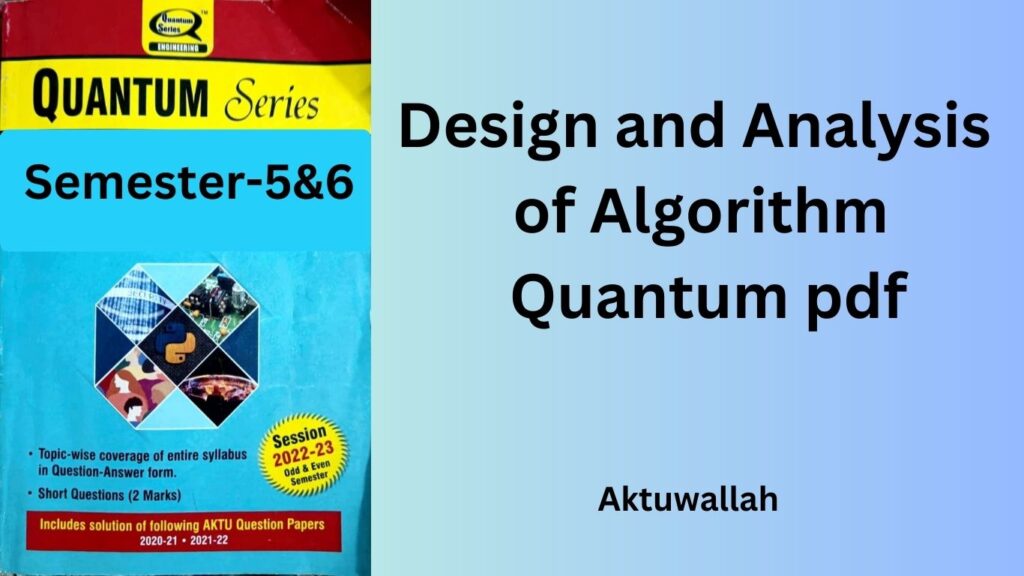Download Design and Analysis of Algorithm Quantum pdf For Aktu B-tech 3rd Year:
Introduction
In the world of computer science and engineering, algorithms play a crucial role in solving complex problems efficiently. The design and analysis of algorithms is a fundamental subject for students pursuing a Bachelor of Technology (B-Tech) degree in AKTU (Dr. A.P.J. Abdul Kalam Technical University). This article aims to provide a comprehensive overview of the key topics covered in the Design and Analysis of Algorithm Quantum PDF for AKTU B-Tech 3rd year students.
How to Download Design and Analysis of Algorithm Quantum PDF for free?
Simply click at the given link to download Design and Analysis of Algorithm Quantum PDF.
GET PDF
Download other quantum pdf for Aktu B-tech 3rd year: Click Here
Download Aktu Syllabus of B-tech 3rd year: Click Here
Download Handwritten Notes of all subjects: Click Here
Visit AKTU official site to explore more
Table of Contents
- Introduction to Algorithm Design
- Asymptotic Notations
- Divide and Conquer Algorithms
- Greedy Algorithms
- Dynamic Programming
- Backtracking Algorithms
- Branch and Bound
- Graph Algorithms
- Network Flow
- NP-Completeness
- Approximation Algorithms
- Randomized Algorithms
- String Matching Algorithms
- Sorting and Searching Algorithms
- Case Studies and Practical Applications
Key topics covered in Design and Analysis of Algorithm Quantum pdf
1. Introduction to Algorithm Design
In this section, students will learn about the fundamental concepts of algorithm design, including problem-solving techniques, algorithmic thinking, and the importance of efficiency in algorithm design.
2. Asymptotic Notations
Asymptotic notations, such as Big O, Omega, and Theta, are vital tools for analyzing the efficiency of algorithms. This topic covers the mathematical representation of algorithmic complexity and the classification of algorithms based on their growth rates.
3. Divide and Conquer Algorithms
Divide and Conquer is a popular algorithmic paradigm that involves breaking down a problem into smaller subproblems, solving them independently, and combining the solutions to obtain the final result. Students will explore various divides and conquer algorithms, such as merge sort, quick sort, and the closest pair problem.
4. Greedy Algorithms
Greedy algorithms make locally optimal choices at each step in the hope of finding a global optimum. This section covers greedy algorithms’ characteristics, applications, and examples, such as the Knapsack problem and minimum spanning trees.
5. Dynamic Programming
Dynamic programming is a powerful algorithmic technique that breaks down a problem into overlapping subproblems and solves them in a bottom-up manner. Students will learn about dynamic programming principles, memorization, and examples like the 0/1 Knapsack problem and the Fibonacci sequence.
6. Backtracking Algorithms
Backtracking algorithms are used to explore all possible solutions to a problem by incrementally building candidates and backtracking when a solution is found or deemed impossible. This topic delves into backtracking algorithms, such as the N-Queens problem and the Sudoku solver.
7. Branch and Bound
Branch and Bound is an algorithmic paradigm for solving optimization problems by systematically exploring the solution space. This section covers the principles of branch and bound, branch and bound tree, and applications like the Traveling Salesman Problem.
8. Graph Algorithms
Graph algorithms play a crucial role in various domains, including network analysis, social networks, and recommendation systems. This topic encompasses graph traversal algorithms (DFS and BFS), shortest path algorithms (Dijkstra’s algorithm), and minimum spanning tree algorithms (Prim’s and Kruskal’s algorithms).
9. Network Flow
Network flow algorithms are used to optimize the flow of resources in a network. Students will learn about maximum flow, minimum cut, and Ford-Fulkerson algorithm, along with their applications in transportation networks and network planning.
10. NP-Completeness
NP-Completeness is a classification of computational problems that are believed to have no efficient solution. This section introduces students to the concept of NP-Completeness, complexity classes, and the famous P vs. NP problem.
11. Approximation Algorithms
Approximation algorithms provide near-optimal solutions for NP-Hard problems. This topic covers approximation ratios, greedy approximation algorithms, and examples like the traveling salesman problem and the knapsack problem.
12. Randomized Algorithms
Randomized algorithms utilize randomization to solve problems more efficiently or with better approximations. Students will explore concepts such as Monte Carlo algorithms and Las Vegas algorithms, along with their applications.
13. String Matching Algorithms
String matching algorithms are used to find occurrences of a pattern within a larger text. This section covers various string matching algorithms, including the brute-force approach, Knuth-Morris-Pratt algorithm, and Rabin-Karp algorithm.
14. Sorting and Searching Algorithms
Sorting and searching algorithms are fundamental to data processing and retrieval. This topic includes popular sorting algorithms like bubble sort, selection sort, insertion sort, and efficient searching algorithms such as binary search and interpolation search.
15. Case Studies and Practical Applications
In this final section, students will explore real-world case studies and practical applications of algorithm design and analysis. Examples may include data compression algorithms, image recognition algorithms, and optimization algorithms used in logistics and scheduling.
Conclusion
The Design and Analysis of Algorithm Quantum PDF for AKTU B-Tech 3rd year provides a comprehensive foundation in algorithmic problem-solving and analysis. By mastering the key topics mentioned above, students can develop efficient algorithms and tackle complex computational problems with confidence.
1 thought on “Download Design and Analysis of Algorithm Quantum”